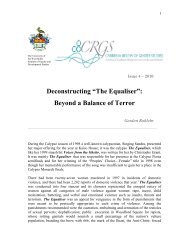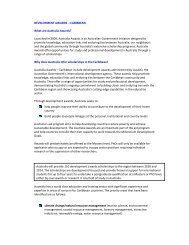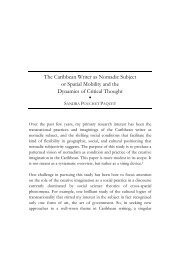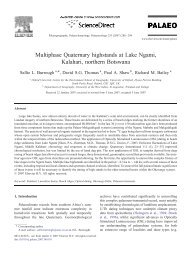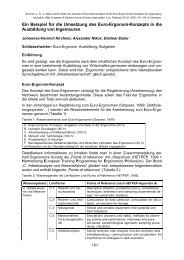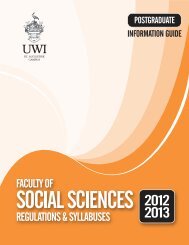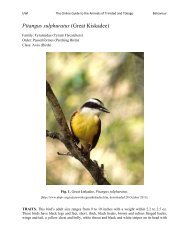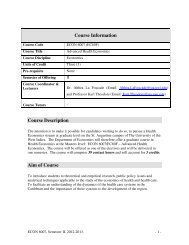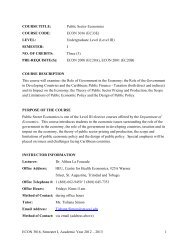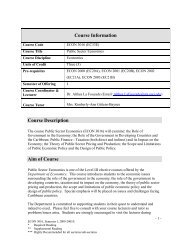Coendou prehensilis
Coendou prehensilis
Coendou prehensilis
Create successful ePaper yourself
Turn your PDF publications into a flip-book with our unique Google optimized e-Paper software.
UWI The Online Guide to the Animals of Trinidad and Tobago Behaviour<br />
<strong>Coendou</strong> <strong>prehensilis</strong> (Tree Porcupine or Brazilian Porcupine)<br />
Family: Erethizontidae (New World Porcupines)<br />
Order: Rodentia (Rodents)<br />
Class: Mammalia (Mammals)<br />
Fig. 1. Brazilian porcupine, <strong>Coendou</strong> <strong>prehensilis</strong>.<br />
[http://animaldiversity.ummz.umich.edu/site/resources/pablo_goncalves/<strong>Coendou</strong>2a.jpg/view.html,<br />
downloaded 22 November 2011]<br />
TRAITS. <strong>Coendou</strong> <strong>prehensilis</strong>, the Brazilian porcupine, is a mid-sized rodent with<br />
evolutionarily modified body hair. This modified hair exists as keratin-toughened, needle-like,<br />
semi-hollow quills or spines that grow to approximately 6.5cm in length. Like all New World<br />
porcupines, spines grow singly out of the skin and possess minute barbs at the end of the shaft.<br />
These spines cover the entire body, except for its fleshy nose, its belly and a large portion of its<br />
prehensile tail, and are usually light in colour (white to burnished yellow); there are also darker<br />
brown to black (soft/ unmodified) hairs interspersed along the body. It has small round eyes; and,<br />
a rounded yet flattened snout. The snout is covered with very short and very fine hairs and has<br />
several long whiskers. The porcupine has two long incisors and the front of its mouth that grows<br />
continuously during life and lacks canine teeth. At adult weight, this porcupine can range from<br />
2kg to 5kg (Roberts et al., 1984). The average length of an adult Brazilian porcupine is<br />
approximately 90cm with its tail contributing about half of that length. <strong>Coendou</strong> also has<br />
modified padded feet with four long clawed toes. At birth, the infants are approximately 50cm<br />
head to tail, 0.415kg, are covered in reddish brown hair and have soft natal quills about 1.5cm in<br />
length that harden a few days after it is born. There is only one offspring per female gestation.
UWI The Online Guide to the Animals of Trinidad and Tobago Behaviour<br />
The Brazilian porcupine is considered to have reached minimum adult weight at the age of<br />
24weeks (Roberts, 1984) but adulthood is reached shortly after weaning at 11weeks (Allen et al.,<br />
2005).<br />
ECOLOGY. The <strong>Coendou</strong> <strong>prehensilis</strong> exists over a large geographical range, including much of<br />
northern South America and Trinidad and Tobago. It is adaptable to changes in its habitat and<br />
lives in tropical and sub tropical forests. <strong>Coendou</strong> <strong>prehensilis</strong> has been consistently been ranked<br />
least concerned of the animal conservation status (Marinho-Filho, 2011). The Brazilian<br />
Porcupine is highly adapted to an arboreal existence, making extensive use of its prehensile tail<br />
and long grasping claws; unlike the North American New World porcupines and the Old World<br />
porcupines which are terrestrial and do not possess these adaptations. <strong>Coendou</strong> spends most of<br />
its time in trees and only travels to the forest floor only when searching for food or to relieve its<br />
bowels. This porcupine is herbivorous and lives mainly off of seeds and fruit but also feeds on<br />
roots, leaves, barks, flowers and stems. It is active in the late evening and during the night; and,<br />
it roosts in trees during the greater portion of the day, therefore, it is considered a nocturnal<br />
species. Males and females produce an oily, strongly-scented secretion to mark domain.<br />
SOCIAL ORGANIZATION. The porcupine is not, for the most part, a social animal. Although<br />
not aggressive, the <strong>Coendou</strong> spends most of its social time in pairs or it lives solitarily. These<br />
porcupines will aggregate in small groups sometimes to sleep but they do not live in a pack or<br />
large family setting (Allen et al., 2005). Parents with young live together but sleep at some<br />
distance from each other and the young. Parents forage and care for young and tolerate a juvenile<br />
even after the birth of another. However, the parents are not protective of young porcupines nor<br />
do they take safety precautions.<br />
ACTIVITY. The Brazilian porcupine is not strictly nocturnal like Hystricidae, becoming active<br />
in the later part of the afternoon. There is a climax level of activity a couple hours before sunset,<br />
at approximately 4pm, and then again at 2am. There is little difference in male and female<br />
activity but young <strong>Coendou</strong> do not move about as the adults do although at birth it possesses a<br />
strong prehensile tail and long grasping toes. Although, the porcupine may leave the canopy to<br />
forage for food, the majority of all activity is arboreal; up to 85% of its time is spent in trees<br />
(Roberts et al., 1984). <strong>Coendou</strong> uses its prehensile tail to help it get around from tree to tree and<br />
to hang from branches. The long toes and padding of its feet help it to grasp branches and small<br />
items almost as efficiently as would an organism with an opposable thumb.<br />
FORAGING BEHAVIOUR. Foraging is done by both males and females and occurs during the<br />
later part of the day, upon waking. Most of the foraging of fruits, seeds, leaves, bark etc is done<br />
from the roosting tree and the surrounding trees. The porcupine may raid trees from nearby<br />
homes, farms and plantations. Primarily arboreal, the <strong>Coendou</strong> <strong>prehensilis</strong> will also descend to<br />
the forest floor to forage for food. Foraging is also done by the adults, the young staying in the<br />
perch.<br />
COMMUNICATION. Most interactions of the <strong>Coendou</strong> are with others of the same species.<br />
While there were long, loud high pitched moans which act as signals to individuals a far way off,<br />
most of the sounds were of high frequency during close friendly interactions. Grunts, growls,
UWI The Online Guide to the Animals of Trinidad and Tobago Behaviour<br />
hisses and sounds made from the rattling of spines were made as threats or warnings in<br />
aggressive interactions (Roberts et al., 1984).<br />
SEXUAL BEHAVIOUR. Female porcupines come into sexual maturity as early as 19weeks,<br />
nine weeks after weaning; male sexual maturity is approximately at 19weeks as well. They begin<br />
to mate promptly upon coming of age, however little is recorded about the mating activities of<br />
the <strong>Coendou</strong>. It is known, however, that females mate and produce young consistently<br />
throughout life and begin copulating as early as three days after giving birth; the gestation period<br />
for a fetus is approximately 203 days (Roberts et al., 1984). Males are noted to urinate on<br />
females prior to mating as well as on both females and their newborn offspring. There is no<br />
apparent mating season.<br />
JUVENILE BEHAVIOUR. Young <strong>Coendou</strong> <strong>prehensilis</strong> do not move from the roost for the<br />
first 2-3 weeks after birth even though it is capable of moving and will do so if disturbed. It is<br />
suckles from the mother every 4-6 hours and it is the mother who initiates and ends the feeding.<br />
Young Brazilian porcupines with engage in long hours of play with each other or a parent,<br />
usually the father.<br />
ANTIPREDATOR BEHAVIOUR. <strong>Coendou</strong> <strong>prehensilis</strong> is not a major target of predation and<br />
is usually non-aggressive when faced with an opponent or potential threat. It may try to retreat or<br />
curl up to protect its belly and simultaneously present its quills to the attacker. When startled, it<br />
may shake causing its spines to rattle, as well as grunt or stomp, as a form of warning.<br />
Aggressive antipredator behaviour is highly successful. The porcupine will at times, charge the<br />
predator quickly while its spines are raised. If contact is made the quills will be released into the<br />
skin of the predator (Allen et al., 2005). The barbs at the end of the spines, ensure that the<br />
embedded quill remains lodged within the skin of the attacker, and will actually cause the spine<br />
to move deeper into the flesh as the attacker moves. This may lead to the infection and likely<br />
death of the attacker.<br />
REFERENCES<br />
Allen, C. J.e, et al. (2005). "New World Porcupines: Erethizontidae." Grzimek's Student Animal Life Resource. Ed.<br />
Catherine Judge Allen, et al. Vol. 18: Mammals: Volume 5. Detroit: UXL, pp. 1121-1128.<br />
Marinho-Filho, J., Queirolo, D. & Emmons, L. 2008. <strong>Coendou</strong> <strong>prehensilis</strong>. In: IUCN 2011. IUCN Red List of<br />
Threatened Species. Version 2011.2. Web accessed November 5 2011:<br />
http://www.iucnredlist.org/apps/redlist/details/5085/0<br />
Roberts, M., Brand, S., Maliniak, E., “The Biology of Captive Prehensile Tailed Porcupine: <strong>Coendou</strong> Prehensilis”<br />
Department of Zoological Research, National Zoological Park, Washington DC, 1984.<br />
http://nationalzoo.si.edu/scbi/SpotlightonVetMedicine/The%20Biology%20of%20Prehensiletailed%20Porcupines.pdf<br />
Author: Rica Charles<br />
Posted online: 2011<br />
For educational use only ‐ copyright of images remains with original source






